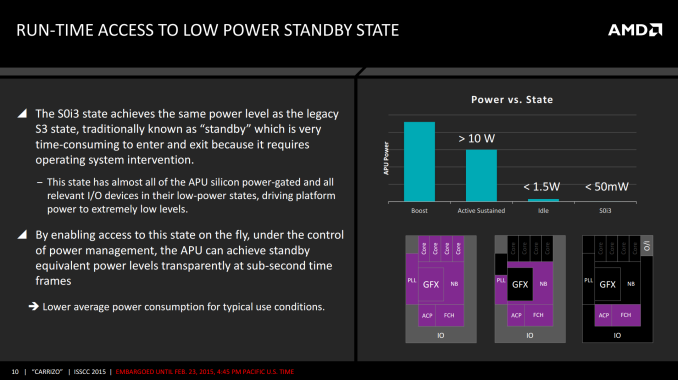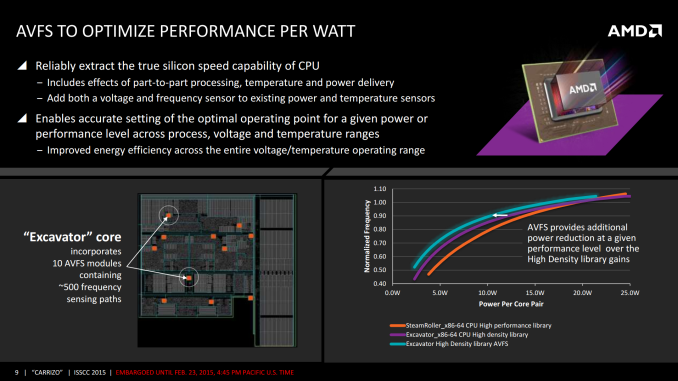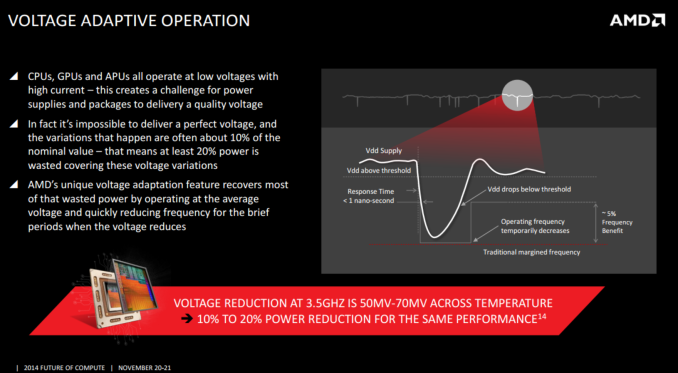AMD Launches Carrizo: The Laptop Leap of Efficiency and Architecture Updates
by Ian Cutress on June 2, 2015 9:00 PM ESTPower Saving and Power Consumption
When it comes to power, Carrizo features two/three technologies worth discussing. The first is the use of low power states, and the different frequency domains within the SoC. Previous designs had relatively few power planes, which left not as many chances for the SoC to power down areas not in use. Carrizo has ten power planes that can be controlled at run-time, allowing for what can be described as a dynamic race to sleep. This is bundled with access to the S0i3 power state, giving sub 50mW SoC power draw when in sleep and wake-up times under a second.
This is also combined with automated voltage/frequency sensors, of which an Excavator core has 10 each. These sensors take into consideration the instructions being processed, the temperature of the SoC, the quality of power delivery as well as the voltage and frequency at that point in order to relay information about how the system should adjust for the optimal power or performance point.
AMD states that this gives them the ability to adjust the frequency/power curve on a per-module basis further again to the right, providing another reduction in power or increase in frequency as required.
Next up for discussion is the voltage adaptive operation that was introduced back in Kaveri. I want to mention it here again because when it was first announced, I thought I understood it at a sufficient level in order to write about it. Well, having crossed another explanation of the feature by David Kanter, the reason for doing so clicked. I’m not going to steal his thunder, but I suggest you read his coverage to find out in more detail, but the concept is this:
When a processor does work, it draws power. The system has to be in a position to provide that power, and the system acts to restabilize the power while the processor is performing work. The work being done will cause the voltage across the processor to drop, to what we classically call Voltage Droop. As long as the droop does not cause the system to go below the minimum voltage required for operation, all is good. Voltage Droop works if the supply of power is consistent, although that cannot always be guaranteed – the CPU manufacturer does not have control over the quality of the motherboard, the power supply or the power conversion at hand. This causes a ripple in the quality of the power, and the CPU has to be able to cope with these ripples as these ripples, combined with a processor doing work, could cause the voltage to drop below the threshold.
The easiest way to cope is to put the voltage of the processor naturally higher, so it can withstand a bigger drop. This doesn’t work well in mobile, as more voltage results in a bigger power draw and a worse experience. There are other potential solutions which Kanter outlines in his piece.
AMD has tackled the problem is to get the processor to respond directly. When the voltage drops below a threshold value, the system will reduce the frequency and the voltage of the processor by around 5%, causing the work being done to slow down and not drain as much. At AMD’s Tech Day, they said this happens in as quickly as 3 cycles from detection, or in under a nanosecond. When the voltage drop is normalized (i.e. the power delivery is a more tolerable level), the frequency is cranked back up and work can continue at a normal rate.
Obviously the level of the threshold and the frequency drop will determine how much time is spent in this lower frequency state. We were told that with the settings used in Carrizo, the CPU hits this state less than 1% of the time, but it accounts for a sizeable chunk of overall average power reduction for a 3.5 GHz processor. This may sound odd, but it can make sense when you consider that the top 5% of the frequency is actually the most costly in terms of power than any other 5%. By removing that 5% extreme power draw, for a minimal performance loss (5% frequency loss for sub 1% of the time), it saves enough power to be worthwhile.













137 Comments
View All Comments
VeixES - Wednesday, June 3, 2015 - link
Some OEM needs to pick this up fast.Carrizo based "NUC" device with HDMI2.0 output with more barebones approach than intel to reduce the cost of entry.
gostan - Wednesday, June 3, 2015 - link
Anandtech - AMD's marketing arm.bloodypulp - Wednesday, June 3, 2015 - link
Dumbest thing I've heard yet today.jabber - Thursday, June 4, 2015 - link
Everyone knows AMD has never had a marketing arm. That's why no one buys em.Seriously, the OEMs have moved on. Why bother with AMD when Intel sells because the average consumer has heard of Intel? Price doesn't come into it.
watzupken - Thursday, June 11, 2015 - link
To gostan, I find your comment above baseless and unconstructive to be honest. One article on AMD means AMD marketing arm. So what does that make you then?l_d_allan - Wednesday, June 3, 2015 - link
My impression is that it will be difficult (almost impossible?) for AMD to compete with a 28nm part against Intel's 14nm parts.And I think the next "tick tock" from Intel will be 10nm. Or not?
Novacius - Wednesday, June 3, 2015 - link
It'll be a tick, codenamed Cannonlake. But i don't expect it before the end of 2016/beginning of 2017.The_Assimilator - Wednesday, June 3, 2015 - link
Which will still be before AMD gets to 14nm.cjs150 - Wednesday, June 3, 2015 - link
Finally AMD release a reasonably power efficient chip.At 15W this is perfect for a passively cooled HTPC with 4k capability built in. I appreciate the HTPC market is small, but AMD have something that potentially (will reserve judgment until it is out and tested) beats everything Intel have comprehensively.
The problem for AMD will be that people like me already have a HTPC (in my case using i7-3770T which is overkill) and until the world moves to 4K there is no need to upgrade but if they produced something the size of Intel NUC but passively cooled I would be very tempted
watzupken - Wednesday, June 3, 2015 - link
I think this makes a very interesting APU. In fact, the most interesting APU from AMD to date. Unfortunately, it may not reach the shores from where I come from. It is either limited availability or the distros are not interested to carry in due to them expecting a low demand.